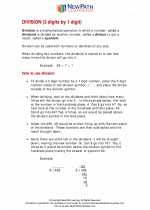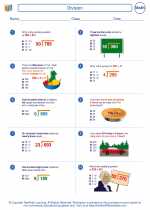Patterns
Patterns are sequences of numbers, shapes, or objects that follow a certain rule or order. Recognizing and understanding patterns is an important skill in mathematics, as it helps develop critical thinking and problem-solving abilities.
Types of Patterns
There are different types of patterns, including:
- Numeric Patterns: These patterns involve sequences of numbers that follow a specific rule or order. For example, 2, 4, 6, 8, 10 is an example of a numeric pattern with a common difference of 2.
- Geometric Patterns: These patterns involve sequences of shapes or objects that follow a specific rule or order. For example, a sequence of squares with increasing side lengths forms a geometric pattern.
- Repeating Patterns: These patterns involve a sequence of elements that repeat in a predictable manner. For example, the colors in a rainbow form a repeating pattern.
Identifying and Extending Patterns
To identify and extend patterns, you can follow these steps:
- Observe the pattern: Look for a recurring sequence or rule in the given set of numbers, shapes, or objects.
- Determine the pattern rule: Once you observe the pattern, try to figure out the rule that governs the sequence. For numeric patterns, this may involve addition, subtraction, multiplication, or division. For geometric patterns, it may involve the arrangement or transformation of shapes.
- Extend the pattern: Use the pattern rule to predict and continue the sequence. This involves applying the same rule to generate the next elements in the pattern.
Practice Questions
Here are some practice questions to help you understand patterns:
- Identify the rule for the following numeric pattern: 3, 6, 9, 12, 15, ...
- Extend the geometric pattern: Triangle, square, pentagon, ...
- Identify the repeating pattern in the sequence: A, B, C, A, B, C, ...
[Patterns] Related Worksheets and Study Guides:
.◂Math Worksheets and Study Guides Sixth Grade. Division
Study Guide Division
Division  Worksheet/Answer key
Worksheet/Answer key Division
Division  Worksheet/Answer key
Worksheet/Answer key Division
Division  Worksheet/Answer key
Worksheet/Answer key Division
Division 

 Worksheet/Answer key
Worksheet/Answer key
 Worksheet/Answer key
Worksheet/Answer key
 Worksheet/Answer key
Worksheet/Answer key

The resources above cover the following skills:
Connections to the Grade 6 Focal Points (NCTM)
Number and Operations: Students' work in dividing fractions shows them that they can express the result of dividing two whole numbers as a fraction (viewed as parts of a whole). Students then extend their work in grade 5 with division of whole numbers to give mixed number and decimal solutions to division problems with whole numbers. They recognize that ratio tables not only derive from rows in the multiplication table but also connect with equivalent fractions. Students distinguish multiplicative comparisons from additive comparisons.